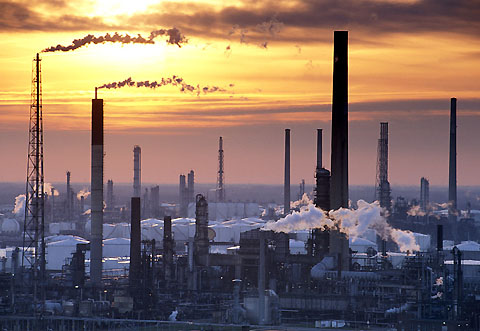Peak Possibilities
by Justin Fox on 21 November 2007 in Time Magazine
In July 2006, the world's oil rigs pumped out crude at a rate of nearly 85.5 million bbl. a day. They haven't come close since, even as prices have risen from $75 to $98 per bbl. Which raises a question of potentially epochal significance: Is it all downhill from here?
It's not as if nobody predicted this. The true believers in what's called peak oil--a motley crew of survivalists, despisers of capitalism, a few billionaire investors and a lot of perfectly respectable geologists--have long cited the middle to end of this decade as a likely turning point.
In the oil industry and the government agencies that work with it, such talk is usually dismissed as premature. There have been temporary drops in oil production before, after all--albeit usually during global economic slowdowns, not boom times. In most official scenarios, production will soon begin rising again, peaking at more than 110 million bbl. a day around 2030.
That's alarming enough in itself. Even the optimists think we have less than three decades to go? But at industry conferences this fall, the word from producers was far gloomier. The chief executives of ConocoPhillips and French oil giant Total both declared that they can't see oil production ever topping 100 million bbl. a day. The head of the oil importers' club that is the International Energy Agency warned that "new capacity additions will not keep up
with declines at current fields and the projected increase in demand."
This isn't quite the same as saying that oil production has peaked and is about to start declining sharply--the view of the true peakists. In "peak lite," as some call it, the big issues are not so much geological as political, technical, financial and even human-resource-related (the world apparently suffers from a dearth of qualified petroleum engineers). These factors all delay the arrival of oil on the market, meaning that production would not so
much peak as plateau. But with demand rising sharply, especially from China and India, even a plateau could be precarious.
It's not that the world is running out of oil. There are massive reserves available in Canadian tar sands, Colorado shale, Venezuelan heavy oil and other unconventional deposits. The problem is that most of this oil is hard to extract and even harder to refine, and it isn't likely to account for a significant share of global production anytime soon. Almost everybody agrees that the pumping of conventionally sourced oil outside the Organization of Petroleum Exporting
Countries (OPEC) has already peaked or will peak soon, a reality that even discoveries like the recent 8 billion-bbl. find off the coast of Brazil can't alter because production from so many existing fields is declining.
The big question mark is OPEC, which represents the oil powers of the Middle East and a few other big exporters and currently accounts for 41% of world oil production. Every optimistic scenario assumes that this share will rise dramatically in the coming decades. That is, if things turn out well, the U.S. will become substantially more dependent on Saudi Arabia and its neighbors. Great!
Then there's the gloomy view. In his 2005 book Twilight in the Desert, energy-industry investment banker Matt Simmons opened up a still raging debate over whether Saudi Arabia, OPEC's top producer, really can pump much more oil than it does now. Since the book appeared, Saudi output has dropped from 9.6 million bbl. a day to 8.6 million, despite rising prices.
Saudi officials used the occasion of an OPEC summit in Riyadh in mid-November to say they could up production at any time. But that raises the pesky question of why they don't. So far, the answer from OPEC leaders has been that high prices are the fault of speculators and the falling dollar, not low production. They're not just blowing smoke. Lynn Westfall, chief economist of refiner Tesoro Corp., says there's more than enough oil for sale right now. The price
pressure, he explains, "is coming from financial participants in futures markets."
If OPEC's members are not able to boost production in coming years, though, it will be impossible to keep blaming the traders as prices rise. What happens then? "If we had better data, we could hold a global summit and say, 'Gentlemen, it's nobody's fault, but we've peaked,'" says Simmons. "We've got to embrace some conservation practices that are draconian, or we will be at war with each other."
Among the peakists, war and economic breakdown are favorite themes. They figure that cheap oil is the essential fuel of modern capitalism, which will founder without it. A more hopeful take is that innovation is the essential fuel of modern capitalism and that high oil prices will drive rapid advances in conservation and alternative energy. Either way, the beginning of the end of the oil era may be upon us, well ahead of schedule. |

